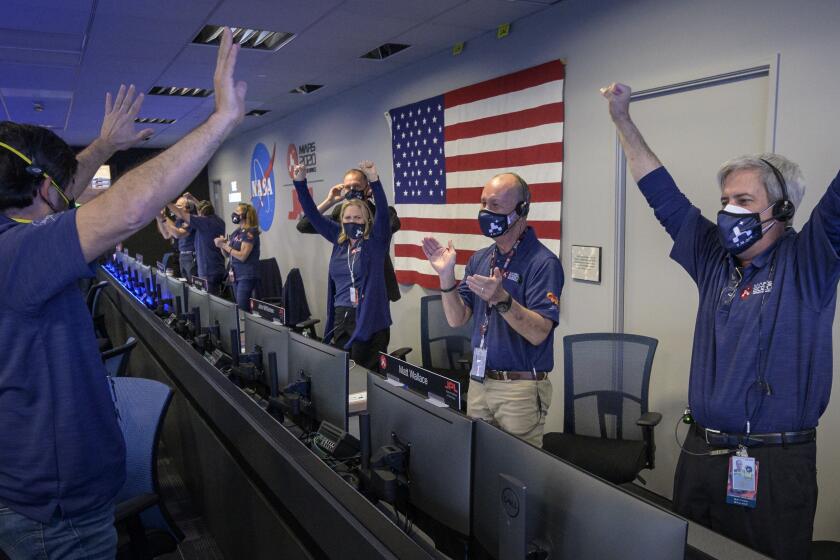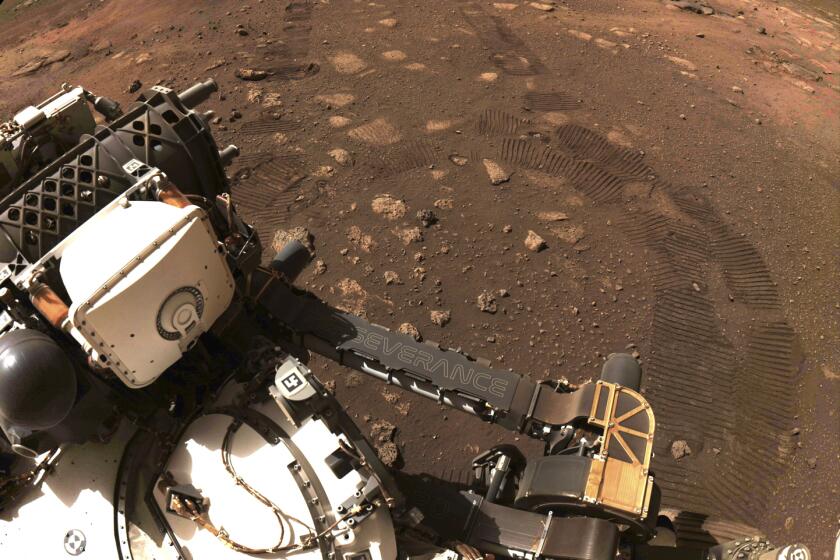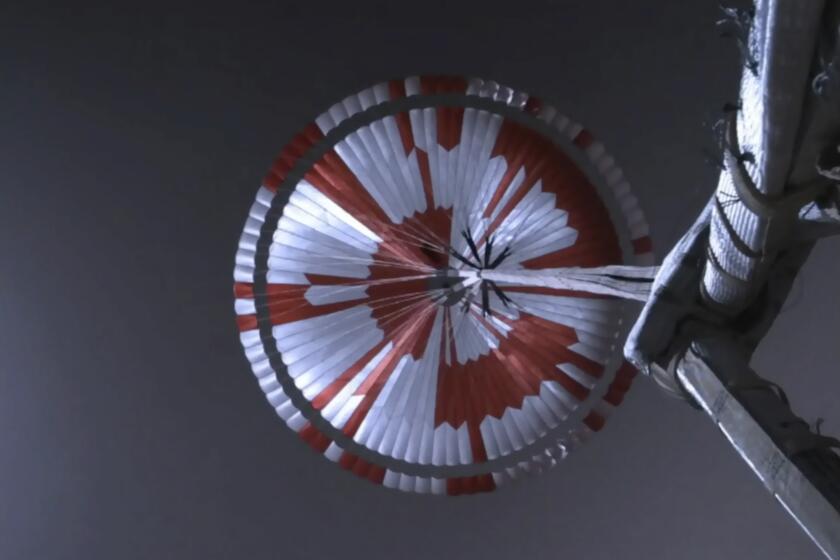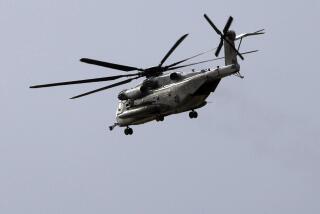Ingenuity, NASA’s little Mars helicopter that could, takes flight — a first on another planet
- Share via
CAPE CANAVERAL, Fla. — NASA’s experimental Mars helicopter rose from the dusty red surface into the planet’s thin air Monday, achieving the first powered flight on another planet.
The triumph was hailed as a Wright brothers moment. In fact, the mini four-pound copter, named Ingenuity, carried a bit of wing fabric from the 1903 Wright Flyer, which made similar history at Kitty Hawk, N.C.
“Altimeter data confirms that Ingenuity has performed its first flight, the first flight of a powered aircraft on another planet,” said the helicopter’s chief pilot back on Earth, Havard Grip, his voice breaking as his teammates erupted in cheers.
It was a brief hop — just 39 seconds — but accomplished all the major milestones.
Project manager MiMi Aung was jubilant as she ripped up the papers holding the plan in case the flight had failed. “We’ve been talking so long about our Wright brothers moment, and here it is,” she said.
Flight controllers at NASA’s Jet Propulsion Laboratory in Pasadena declared success after receiving data via the Perseverance rover, which stood watch more than 200 feet away. Ingenuity hitched a ride to Mars on Perseverance, clinging to the rover’s belly upon their arrival in an ancient river delta in February.
NASA’s newest rover touched down safely on the surface of Mars in Jezero Crater
The $85-million helicopter demo was considered high-risk but high-reward. “Each world gets only one first flight,” Aung said earlier this month.
Scientists cheered the news from around the world, and even from space: “The shadow of greatness, #MarsHelicopter first flight on another world complete!” NASA astronaut Victor Glover tweeted from the International Space Station.
“A whole new way to explore the alien terrain in our solar system is now at our disposal,” said Nottingham Trent University astronomer Daniel Brown.
This first test flight — with more to come by Ingenuity — holds great promise, Brown noted. Future helicopters could serve as otherworldly scouts for rovers and, eventually, astronauts in difficult, dangerous locales.
NASA’s newest Mars rover hit the dusty red road this week, putting 21 feet on the odometer.
Aung and her team had to wait more than three excruciating hours before learning whether the pre-programmed flight had succeeded 178 million miles away. Adding to their anxiety: A software error prevented the helicopter from lifting off a week earlier and had engineers scrambling to come up with a fix.
When the news finally came, the operations center filled with applause, cheers and laughter. More followed when the first black-and-white photo from Ingenuity appeared on their screens, showing its shadow as it hovered above the surface of Mars. Next came the stunning color images of the helicopter descending back to the surface, taken by Perseverance, “the best host little Ingenuity could ever hope for,” Aung said in thanking everyone.
The helicopter achieved its planned altitude of 10 feet, according to the altimeter data, and hovered for a full 30 seconds, appearing stable. For duration, that beats the Wright brothers’ Wright Flyer, whose first flight lasted a mere 12 seconds on Dec. 17, 1903.
To accomplish all that, the helicopter’s twin, counter-rotating rotor blades needed to spin at 2,500 revolutions per minute, five times faster than on Earth. With an atmosphere just 1% the thickness of Earth’s, engineers had to build a helicopter light enough — with blades spinning fast enough — to generate this otherworldly lift. At the same time, it had to be sturdy enough to withstand the Martian wind and extreme cold.
Systems engineer Ian Clark used a binary code to spell out a message in the orange-and-white strips of the rover’s parachute.
More than six years in the making, Ingenuity is a barebones 1.6 feet tall, a spindly four-legged chopper. Its fuselage, containing all the batteries, heaters and sensors, is the size of a tissue box. The carbon-fiber, foam-filled rotors are the biggest pieces: Each pair stretches 4 feet tip to tip.
The helicopter is topped with a solar panel for recharging the batteries, crucial for its survival during the minus-130-degree Fahrenheit Martian nights.
NASA chose a flat, relatively rock-free patch for Ingenuity’s airfield, measuring 33 feet by 33 feet. It turned out to be less than 100 feet from the original landing site in Jezero Crater. The helicopter was released from the rover onto the airfield April 3. Flight commands were sent Sunday, after controllers sent up a software correction for the rotor blade spin-up.
Following Monday’s success, NASA named the Martian airfield “Wright Brothers Field.”
“While these two iconic moments in aviation history may be separated by time and 173 million miles of space, they now will forever be linked,” NASA’s science missions chief Thomas Zurbuchen announced.
Breaking News
Get breaking news, investigations, analysis and more signature journalism from the Los Angeles Times in your inbox.
You may occasionally receive promotional content from the Los Angeles Times.
The little chopper with a giant job attracted attention from around the world, from the moment it launched with Perseverance in July until now. Even Arnold Schwarzenegger joined in the fun, rooting for Ingenuity over the weekend via Twitter.
“Get to the chopper!” he shouted, re-enacting a line from his 1987 sci-fi film “Predator.”
Up to five helicopter flights are planned, each one increasingly ambitious. If successful, the demo could lead to a fleet of Martian drones in decades to come, providing aerial views, transporting packages and serving as lookouts for human crews. On Earth, the technology could enable helicopters to reach new heights, such as navigating the Himalayas more easily.
“This gives us amazing hope for all of humanity,” Zurbuchen tweeted. Indeed, JPL’s mantra, “Dare Mighty Things,” was printed on a wall of the control room.
NASA and the European Space Agency have a complex plan to collect samples of Martian rock and soil and send them to Earth. Here’s how it will work.
Ingenuity’s team has until the beginning of May to complete the test flights. That’s because the rover needs to get on with its main mission: collecting rock samples that could hold evidence of past Martian life, for return to Earth a decade from now.
Until then, Perseverance will keep watch over Ingenuity. Flight engineers affectionately call them Percy and Ginny.
“Big sister’s watching,” said Elsa Jensen of Malin Space Science Systems, the rover’s lead camera operator.
More to Read
Sign up for Essential California
The most important California stories and recommendations in your inbox every morning.
You may occasionally receive promotional content from the Los Angeles Times.













